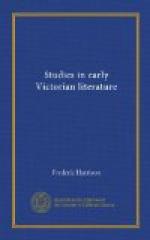originality, its irrepressible drolleries, its substantial
human nature, and its intense vitality, place it quite
in a class by itself. We can no more group it,
or test it by any canon of criticism, than we could
group or define
Pantagruel or
Faust.
There are some works of genius which seem to transcend
all criticism, of which the very extravagances and
incoherences increase the charm. And
Pickwick
ought to live with
Gil Blas and
Tristram
Shandy. In a deeper vein, the tragic scenes
in
Oliver Twist and in
Barnaby Rudge
must long hold their ground, for they can be read
and re-read in youth, in manhood, in old age.
The story of Dotheboys Hall, the Yarmouth memories
of Copperfield, Little Nell, Mrs. Gamp, Micawber, Toots,
Captain Cuttle, Pecksniff, and many more will long
continue to delight the youth of the English-speaking
races. But few writers are remembered so keenly
by certain characters, certain scenes, incidental
whimsies, and so little for entire novels treated strictly
as works of art. There is no reason whatever
for pretending that all these scores of tales are
at all to be compared with the best of them, or that
the invention of some inimitable scenes and characters
is enough to make a supreme and faultless artist.
The young and the uncritical make too much of Charles
Dickens, when they fail to distinguish between his
best and his worst. Their fastidious seniors
make too little of him, when they note his many shortcomings
and fail to see that in certain elements of humour
he has no equal and no rival. If we mean Charles
Dickens to live we must fix our eye on these supreme
gifts alone.
VII
CHARLOTTE BRONTE
They who are still youthful in the nineties can hardly
understand the thrill which went through us all in
the forties upon the appearance of Jane Eyre,
on the discovery of a new genius and a new style.
The reputation of most later writers grew by degrees
and by repeated impressions of good work. Trollope,
George Eliot, Stevenson, George Meredith, did not
conquer the interest of the larger public until after
many books and by gradual widening of the judgment
of experts. But little Charlotte Bronte, who
published but three tales in six years and who died
at the age of thirty-eight, bounded into immediate
fame—a fame that after nearly fifty years
we do not even now find to have been excessive.
And then, there was such personal interest in the
writer’s self, in her intense individuality,
in her strong character; there was so much sympathy
with her hard and lonely life; there was such pathos
in her family history and the tragedy which threw
gloom over her whole life, and cut it off in youth
after a few months of happiness. To have lived
in poverty, in a remote and wild moorland, almost friendless
and in continual struggle against sickness, to have
been motherless since the age of five, to have lost




